Plextor recently announced the release of the M5M mSATA SSD designed specifically for Ultrabooks. The drive offers an mSATA form factor with SATA 6.0Gbps interface, Marvell 88SS9187 controller and Toshiba 19nm Toggle NAND flash. The SSD, paired with custom Plextor firmware, drive performance numbers of up to 540MB/s and 430MB/s sequential read and write respectively and random read and write IOPS of up to 79,000 and 77,000.
A hot topic at this year’s CES was around the new DEVSLP standard being implemented for the release of Intel’s Haswell based Ultrabooks later the year. The challenge with all mobile devices is how to get the best user experience while using the least amount of power consumption. DEVSLP is a SATA standard which helps address the need to consume less power and provide extended battery life to today’s mobile devices, while providing rapid wake times. The M5M mSATA supports DEVSLP, which can reduce power consumption to 1mW and resume from DEVSLP mode in 100ms. The fact that Plextor was able to meet this standard with a SSD design that relies on a power hogging DRAM cache is impressive. Other vendors without a DRAM cache have a tremendous design advantage when it comes to meeting the DEVSLP spec.
The M5M mSATA also features two exclusive Plextor technologies; True Speed and True Protect. True Speed is an in-house firmware that works to prevent SSD speed drops and automatically maintains performance at like-new state over time. True Protect is a multi-layer system, combining the latest 128-bit error correction built into the Marvell controller with Plextor’s exclusive firmware-based Robust Data Hold-out algorithm. The M5M also features 256-bit AES full-drive encryption, ensuring maximum data security.
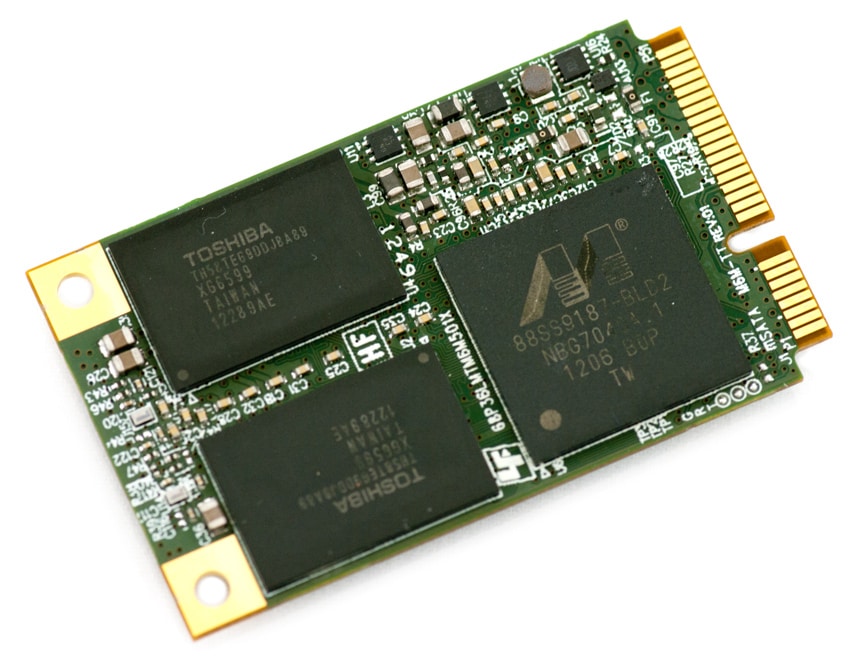
The Plextor M5M mSATA is shipping now in capacities of 64GB, 128GB and 256GB with street pricing of $88, $125 and $230 respectively at the time of this review. Our review model is the 256GB capacity.
Plextor M5M mSATA Specifications
- Capacities
- 64GB (PX-64M5M)
- Sequential Read: up to 540 MB/s
- Sequential Write: up to 160 MB/s
- Random Read IOPS: up to 73,000
- Random Write IOPS: up to 42,000
- 128GB (PX-128M5M)
- Sequential Read: up to 540 MB/s
- Sequential Write: up to 320 MB/s
- Random Read IOPS: up to 80,000
- Random Write IOPS: up to 76,000
- 256GB (PX-256M5M)
- Sequential Read: up to 540 MB/s
- Sequential Write: up to 430 MB/s
- Random Read IOPS: up to 79,000
- Random Write IOPS: up to 77,000
- 64GB (PX-64M5M)
- Controller: Marvell 88SS9187
- DRAM Cache:
- 64GB: 128MB DDR3
- 128GB: 256MB DDR3
- 256GB: 512MB DDR3
- Interface: SATA 6Gb/s
- Form Factor: mSATA
- Dimensions (LxWxH): 50.8 x 29.8 x 3.6 mm
- Weight: 9 grams
- Power Consumption: 0.2W (MobileMark)
- MTBF: 2.4 million hours
- Operating Temp: 0°C – 70°C
- Warranty: 3 Years
Aesthetics and Disassembly
The Plextor M5M has a standard mSATA form-factor, with a SATA 6Gb/s interface. The components are exposed by design, so it takes the fun away from disassembling the drive to see what makes it tick on the inside. The top includes a Marvell 88SS9187-BLD2 controller and two Toshiba TH58TE690DJBA89 64GB 19nm MLC Toggle NAND. We expect to see the Marvell 88SS9187 controller to start appearing on newer 2.5-inch SSDs powered by Marvell controllers.

On the bottom of the M5M mSATA, you’ll find two more Toshiba TH58TE690DJBA89 64GB 19nm MLC Toggle NAND and a DDR3 4Gb (512MB) Nanya low-voltage module for the drive’s DRAM cache.
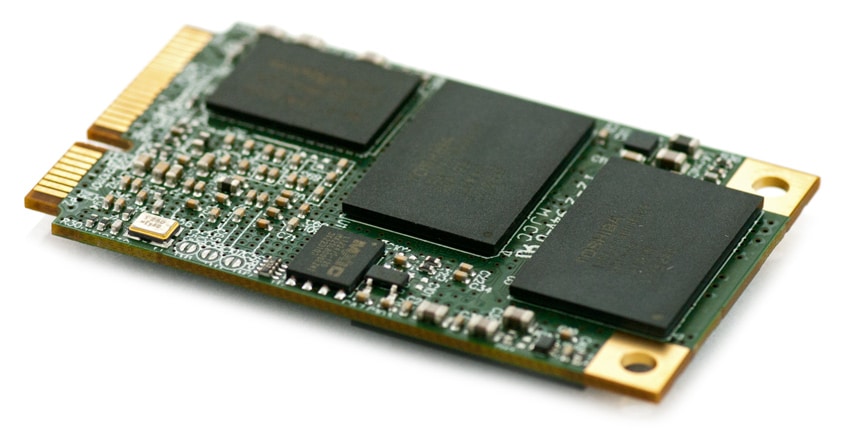
Consumer Benchmarks
All consumer SSD benchmarks are conducted with the StorageReview Consumer Testing Platform, with a mSATA interposer card. The comparable’s used for this review include:
- Plextor M5M mSATA 256GB
- OCZ Nocti mSATA 120GB SSD
- Micron RealSSD C400 mSATA 128GB
- Intel 310 mSATA 80GB SSD
All IOMeter figures are represented as binary figures for MB/s speeds.
Our first test measures peak straight-line performance through a large-block sequential transfer. Plextor lists a peak read speed of 540MB/s and a write speed of 430MB/s.
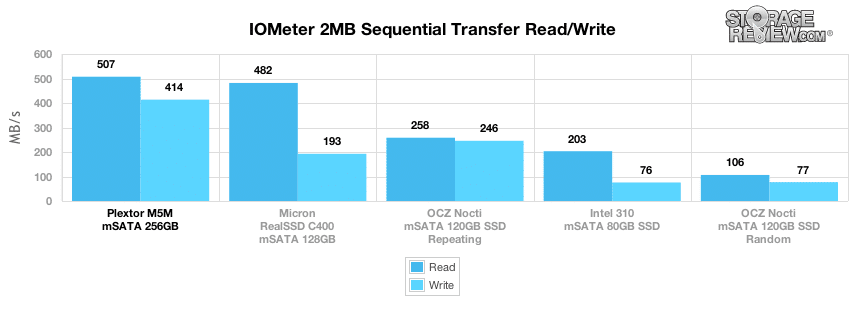
In a sequential transfer test, we measured an average speed of 507MB/s read and 414MB/s write. The speeds came in slightly lower than the spec, but with write performance twice as fast as the nearest drive, we won’t complain too much.
Our next test looks at random 2MB transfers instead of sequential, showing what performance might look like during multiple file transfer requests.
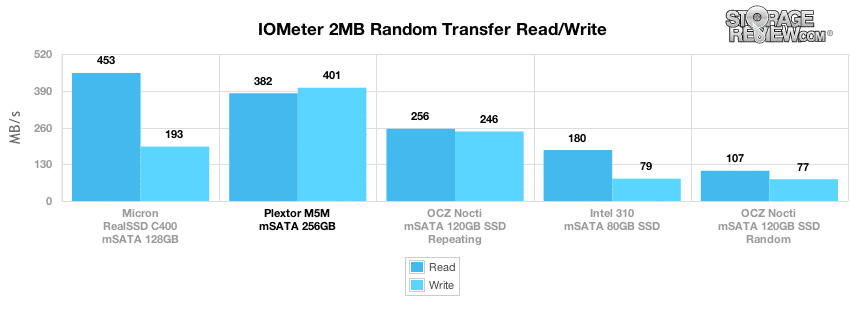
Switching to random large-block transfers, the M5M measured 382MB/s read and 401MB/s write. We saw a 125MB/s drop in read speeds switching to random large-block transfers, which the Micron RealSSD C400 took the lead. The M5M mSATA still nearly doubles the write performance of any of the other drives.
Moving on to even smaller transfer request sizes, our next section looks at random 4K read and write performance at a queue depth of one, and later moves to expanded queue depth tests.
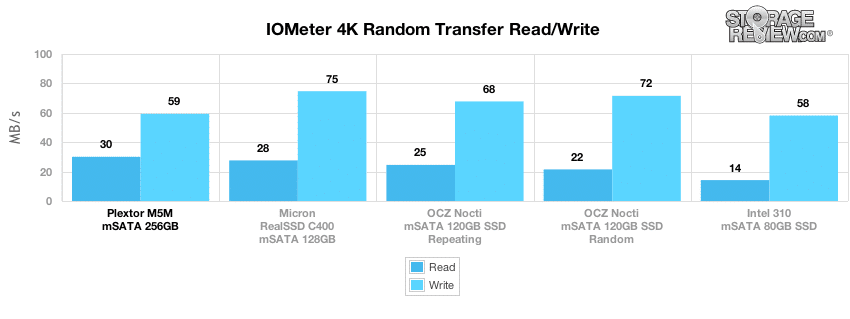
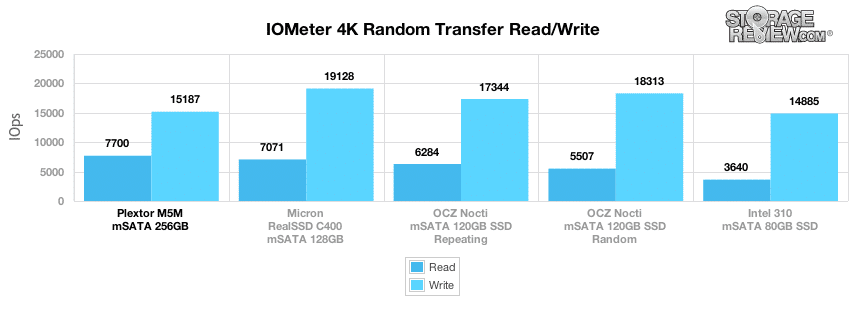
The M5M mSATA offered the strongest low queue-depth performance out of the group in read performance, measuring 7,700 IOPS read. It takes a backseat to the Micron and OCZ drives with its 15,187 IOPS write performance.
In our next test, we shift to a smaller 4k random workload, with 100% read activity that scales from 1QD to 64QD. In this setting, the Plextor M5M mSATA starts off at the head of the pack and scales to just under 80,000 IOPS.
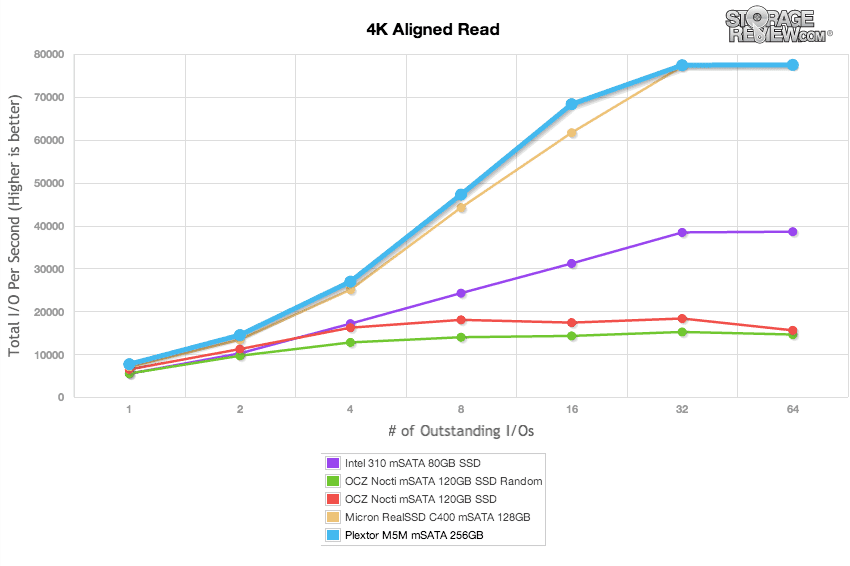
In our next test looking at 100% 4K random write performance, the Plextor M5M mSATA starts in the middle of the pack but takes the lead at queue depth 4 and peaking at just over 75,000 IOPS.
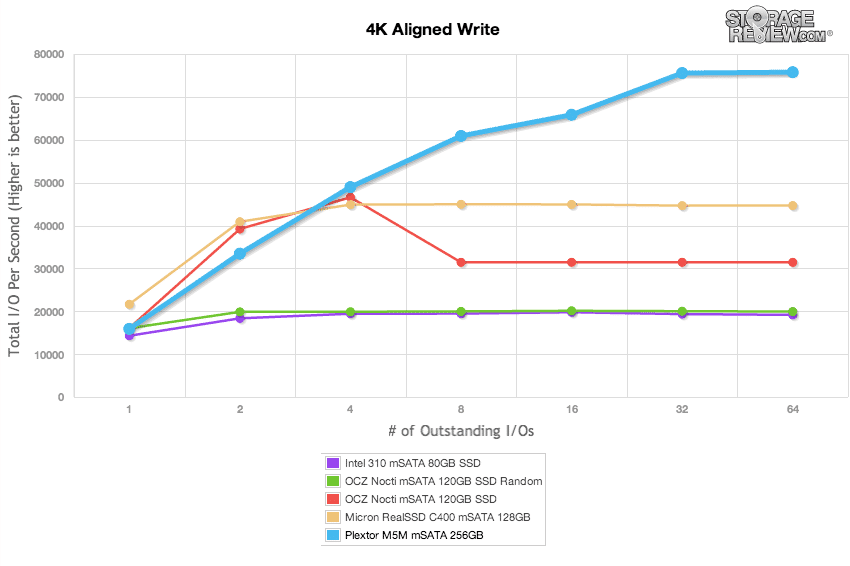
In our 4K write latency test, which measures access times at a queue depth of 1, the M5M mSATA performed below the Micron and OCZ mSATA drives with 0.0541ms. Peak latency was excellent, measuring 7.47ms, just off the mark of the Micron’s leading peak latency of 1.45ms.
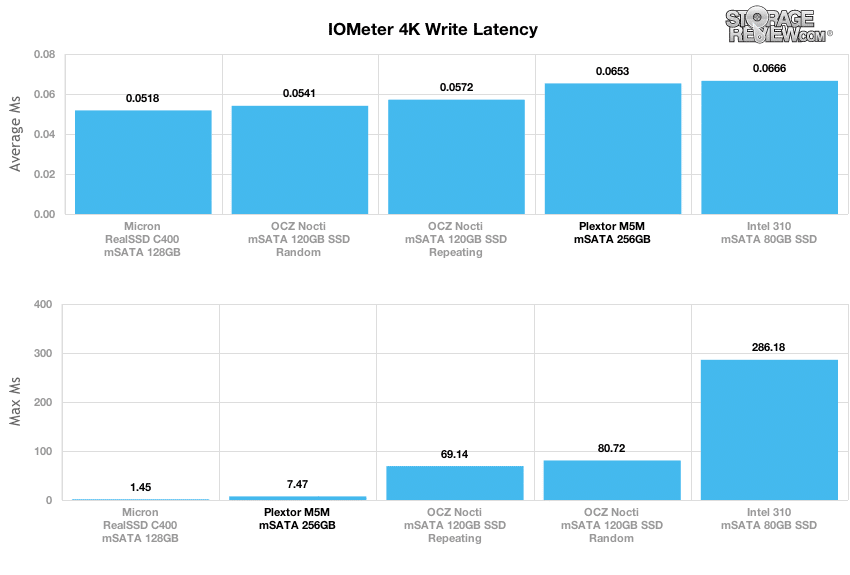
Our last group of consumer IOMeter synthetic benchmarks looks at mixed-load server profiles including Database, Workstation, File Server, and Webserver. In all areas except the read-only Webserver profile, the M5M mSATA outpaced the pack of the other mSATA SSDs at every queue depth.
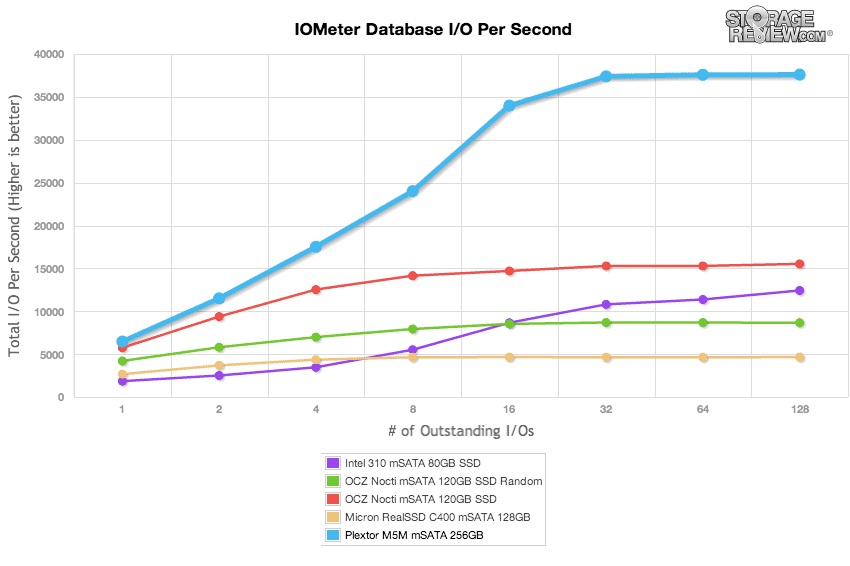
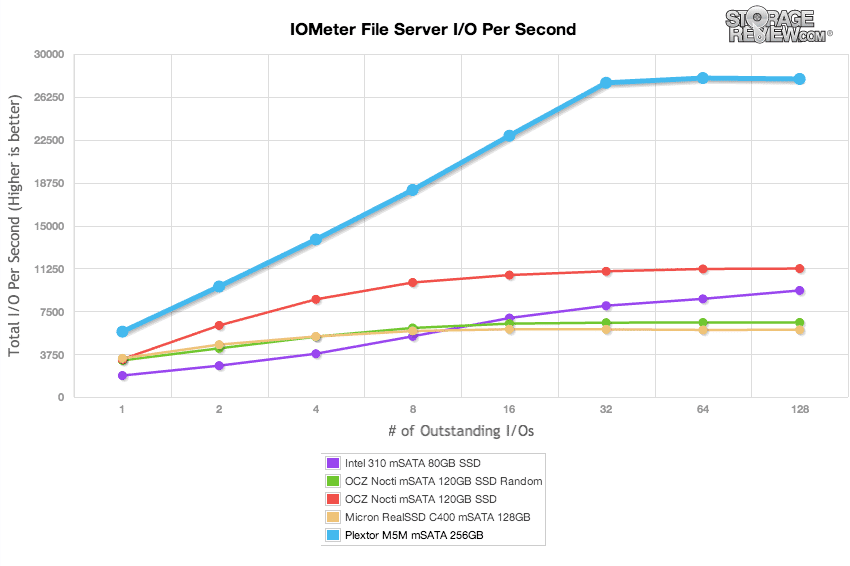
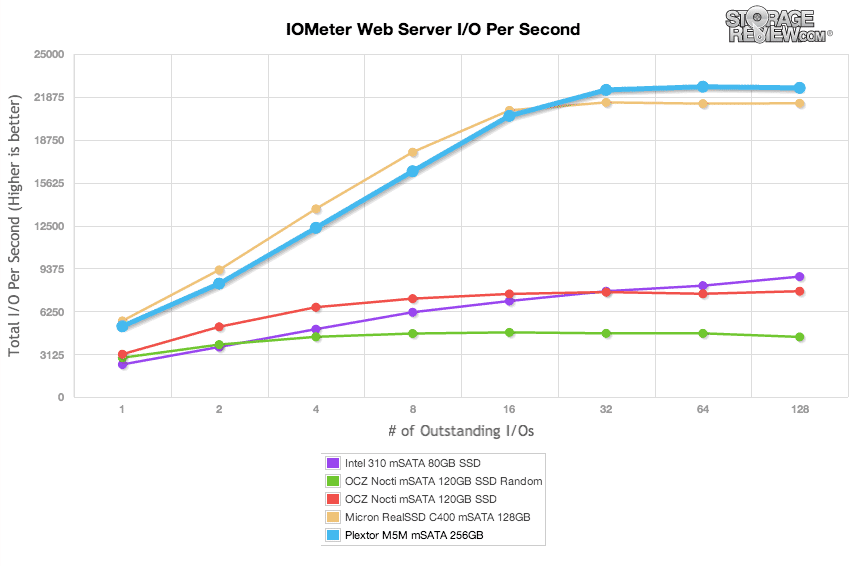
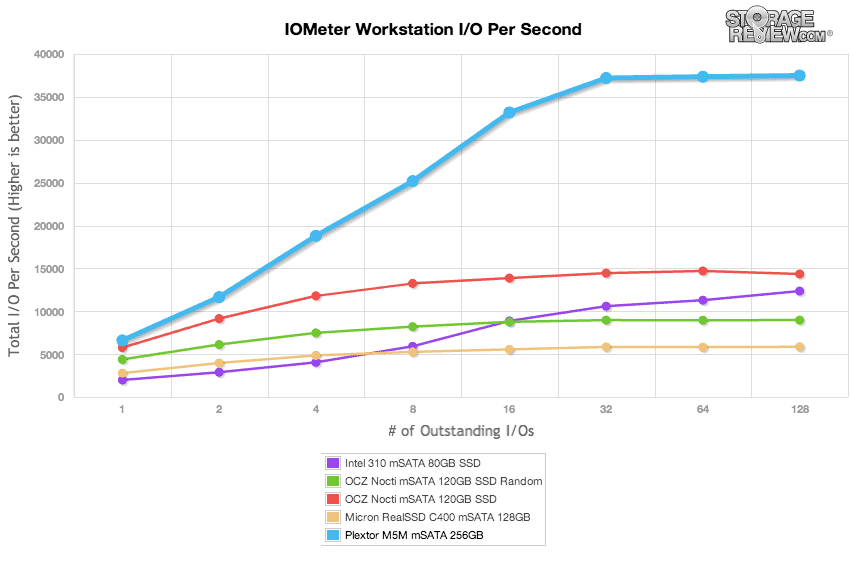
Consumer Real-World Benchmarks
For the average consumer, trying to translate random 4K write speeds into an everyday situation is pretty difficult. It helps when comparing drives in every setting possible, but it doesn’t exactly work out into faster everyday usage or better game loading times. For this reason we turned to our StorageMark 2010 traces, which include HTPC, Productivity, and Gaming traces to help readers find out how a drive might rank under their conditions.
The first real-life test is our HTPC scenario. In this test we include: playing one 720P HD movie in Media Player Classic, one 480P SD movie playing in VLC, three movies downloading simultaneously through iTunes, and one 1080i HDTV stream being recorded through Windows Media Center over a 15 minute period. Higher IOps and MB/s rates with lower latency times are preferred. In this trace we recorded 2,986MB being written to the drive and 1,924MB being read.
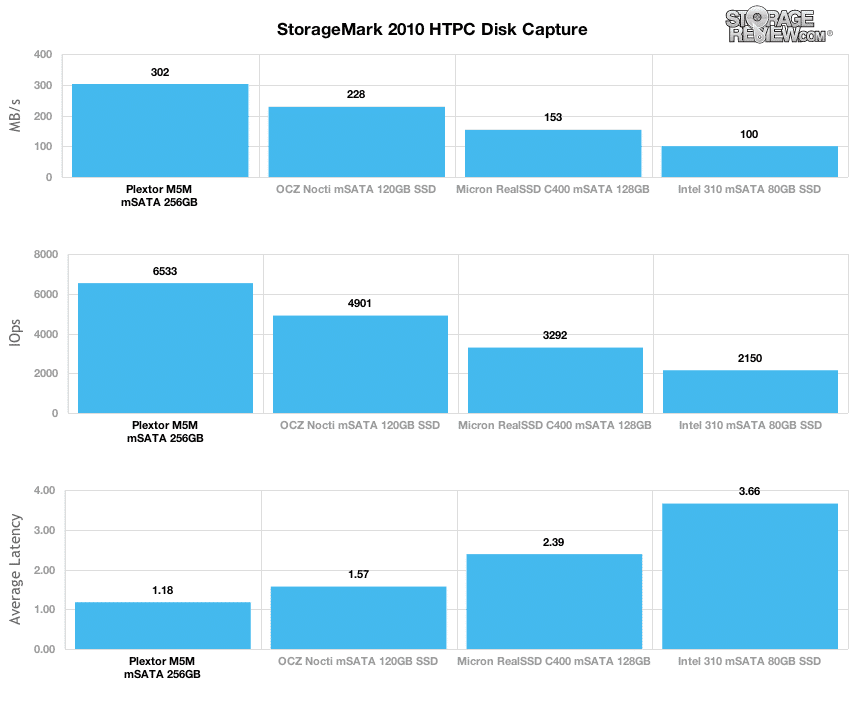
In our HTPC trace the M5M mSATA measured 302MB/s average, 6,553 IOPS and 1.18ms average latency, which leads the other group of mSATA drives.
Our second real-life test covers disk activity in a productivity scenario. For all intents and purposes this test shows drive performance under normal daily activity for most users. This test includes: a three hour period operating in an office productivity environment with 32-bit Vista running Outlook 2007 connected to an Exchange server, web browsing using Chrome and IE8, editing files within Office 2007, viewing PDFs in Adobe Reader, and an hour of local music playback with two hours of additional online music via Pandora. In this trace we recorded 4,830MB being written to the drive and 2,758MB being read.
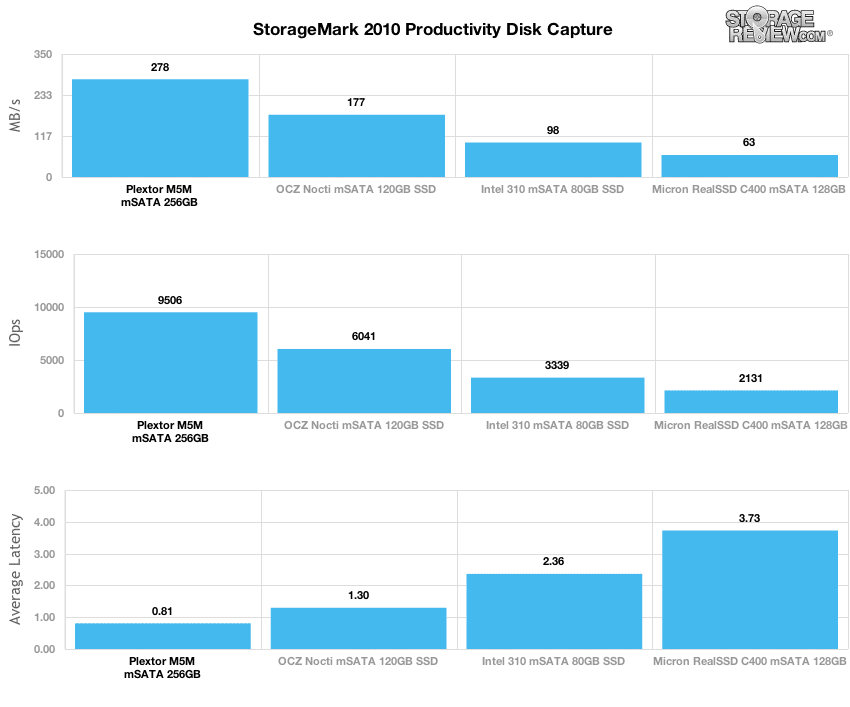
In our Productivity trace, we measured an average speed of 278MB/s, 9,506 IOPS and 0.81ms average latency, which leads the other group of mSATA drives.
Our third real-life test covers disk activity in a gaming environment. Unlike the HTPC or Productivity trace, this one relies heavily on the read performance of a drive. To give a simple breakdown of read/write percentages, the HTPC test is 64% write, 36% read, the Productivity test is 59% write and 41% read, while the gaming trace is 6% write and 94% read. The test consists of a Windows 7 Ultimate 64-bit system pre-configured with Steam, with Grand Theft Auto 4, Left 4 Dead 2, and Mass Effect 2 already downloaded and installed. The trace captures the heavy read activity of each game loading from the start, as well as textures as the game progresses. In this trace we recorded 426MB being written to the drive and 7,235MB being read.
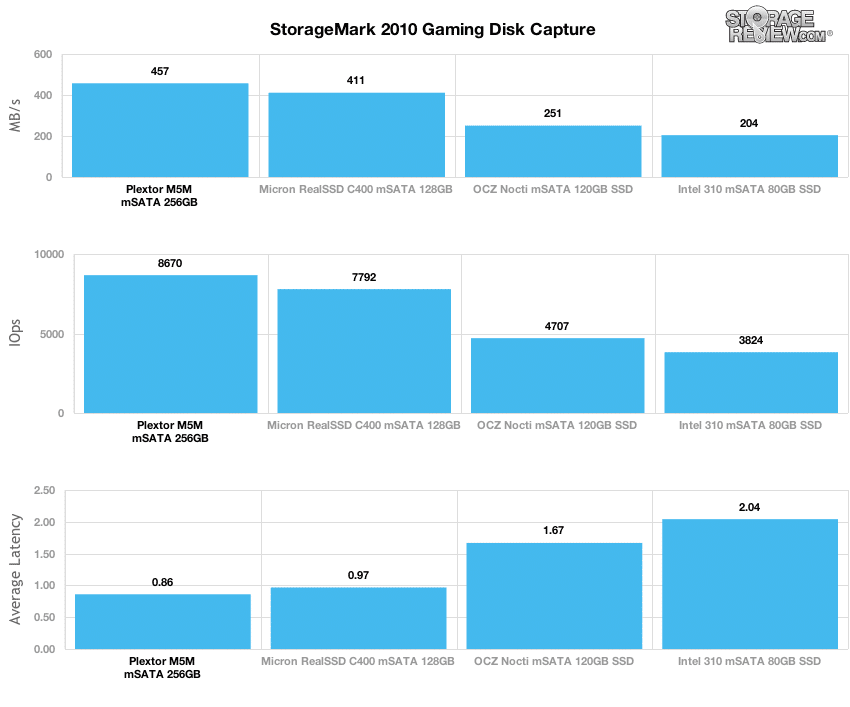
In our read-intensive Gaming trace, the M5M mSATA was able again lead the pack of other mSATAs with performance numbers of 457MB/s, 8,670 IOPS and 0.86ms average latency.
Power Consumption
When looking at any modern SSD, power consumption is a huge deciding factor for many mobile shoppers, since the drive itself can make up a large portion of the total power used in a given notebook. In our power consumption tests we look at how much a given drive draws during read and write activities, as well as startup requirements and idle.
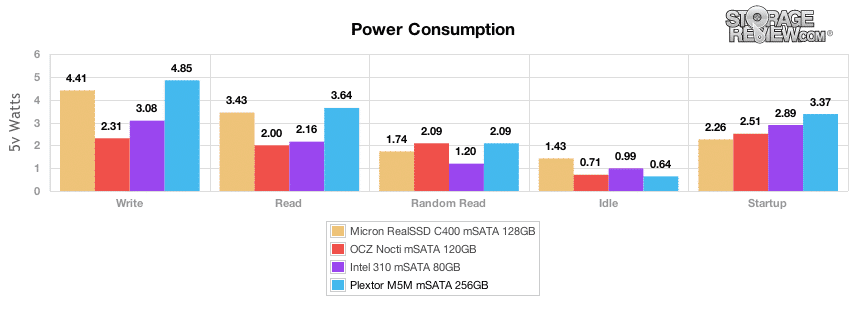
At Idle, we are seeing the benefits of Intel’s new reference specification for DEVSLP, which provides the lowest level of idle power at 0.64 watts. During usage, we are seeing the effects of the DRAM cache, which requires additional power. We measured average write activity of 4.85 watts, sequential read using 3.64 watts, random read needing 2.09 watts, and startup consuming 3.37 watts.
Conclusion
The Plextor M5M mSATA SSD gives users a solid performing option for ultrathin computers, tablets and even standard notebooks. With Intel’s push for DEVSLP standard implementation with the release of Haswell based Ultrabooks in 2013, the M5M mSATA has already complied with these requirements to meet both current and future needs in regard to the quest for more performance with less power consumption. With the Ultrabook and tablet market continuing to expand, the M5M mSATA also offers a great caching option, while the higher capacity models are can perform right up there with 2.5″ SSDs as primary storage.
With the M5M, we saw the fastest performance numbers to date out of an mSATA SSD in our real-world traces. The numbers coming from the M5M mSATA put the drive in-line with performance numbers seen with the Corsair Neutron GTX 240GB and Plextor’s own PX-M5S SSD drives. In some tests, the M5M out performed the popular Samsung 840 Pro 512GB and OCZ Vector 256GB. Overall for users looking for another option in the mSATA SSD space, the Plextor M5M mSATA provides very fast speeds.
Pros
- Class-leading Performance
- Strong performance in our real-world traces
- Excellent mixed-workload throughput
Cons
- Higher power consumption when in use
- Falls behind in low queue-depth random 4K write performance
Bottom Line
The Plextor M5M mSATA delivers by providing some of the fastest speeds to date in the mSATA category. With it meeting the new Intel DEVSLP standard, the drive proves a great option for users looking to upgrade their ultrathin computers now while meeting power standards for the next generation Ultrabook spec.




 Amazon
Amazon